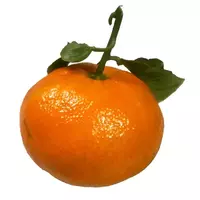Tangerine

Tangerine mandarin (Citrus reticulate Blanco var. Tangerine) is a small citrus tree with a thick crown and rather small narrow leaves. In its appearance, tangerine is not much different from the usual well-known mandarin. The tangerine plant belongs to the Rutov family. Notably, tangerin is not the accepted scientific name for a particular citrus plant species.
Tangerine mandarin is knocked out of the accepted classification, therefore, officially this plant is not isolated into a separate species, but is considered as mandarin fruit. As a rule, tangerine is called a type of tangerine with a thin skin and a bright saturated juicy tangerine taste of pulp. Even in the literal translation, the name of the tangerine plant sounds like "orange mandarin. "
It is worth noting that it is tangerine tangerine that is considered the most common citrus fruit growing in China. Tangerine mandarin belongs to the genus Citrus and is an evergreen bush that does not exceed 4 meters in height. For the first time, Chinese tangerines in Europe were learned only in the 19th century.
Currently, many varieties of tangerines, including tangerin, are grown in Spain, France, Algeria, Georgia, Morocco, Japan, Azerbaijan and Argentina. Tangerin is eaten fresh and processed. Since the vitamin-mineral composition of tangerin fruits contains a large number of different useful natural compounds, the fruit has long been used as a medicine of Chinese folk medicine.
Fruit juices, jam, jams, as well as confitur are made from tangerin fruits. In addition, tangerin is considered an essential ingredient in the preparation of some sauces, as well as dishes from fish, rice and poultry. Tangerin is part of the national Asian sweets, pastries and fruit salads. Currently, breeders have bred several varieties of tangerine tangerine among which the following most popular and common can be distinguished:
ballroom tangerin, a fruit with a sweet and sour taste, as well as a dark orange peel, which is very easy to remove from the fruits;
honey tangerin is characterized by a sweet rich taste, since the composition of the plant fruits contains a large amount of sucrose of natural origin;
Minneolian tangerin is a hybrid of mandarin and grapefruit that is distinguished by its pear-shaped shape.
As a result of the studies carried out, it was found that regular consumption of tangerin fruits contributes to an increase in the immunity of the human body. In addition, tangerin has an antispasmodic, antiseptic and tonic effect. Often tangerin is used as a natural calming agent. Based on tangerin, essential oil is obtained, which has found active use in cosmetology, folk and official medicine.
tangerina 53 kCal
Energy value of tangerin (Ratio of proteins, fats, carbohydrates - ju):
Proteins: 0.81 g (~ 3 kCal)
Fats: 0.31 g (~ 3 kCal)
Carbohydrates: 11.54 g (~ 46 kCal)
Energy ratio (bj | y): 6% | 5% | 87%
 Español
Español Français
Français Português
Português Русский
Русский 简体中文
简体中文 繁體中文
繁體中文 日本語
日本語 한국어
한국어 العربية
العربية Türkçe
Türkçe Қазақ
Қазақ Deutsch
Deutsch Italiano
Italiano Українська
Українська
